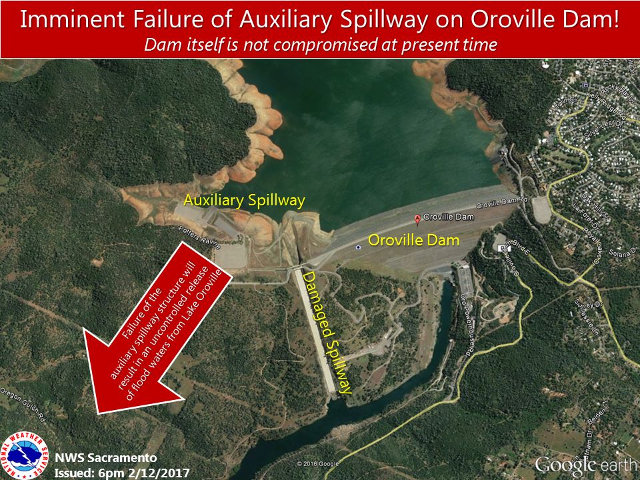Oroville, CA…ALERT-ALERT-ALERT — Yes, an evacuation has been ordered. All Yuba County on the valley floor. The auxiliary spillway is close to failing. Please travel safely. Contact family and friends. Help the elderly.
Take only routes to the east, south, or west. DO NOT TRAVEL NORTH TOWARD OROVILLE!!!!!

Traffic backed up getting out of Marysville due to evacuation notice for Oroville Adam. pic.twitter.com/3tlSCmlwky
— Caltrans District 3 (@CaltransDist3) February 13, 2017
Below is from Wikipedia on the spillway issues…
“2017 spillway failure[edit]
On February 7, 2017, during ongoing flood control release of about 50,000 cubic feet per second (1,400 m3/s), a crater appeared in the Oroville Dam spillway.[22] High inflows to Lake Oroville forced dam operators to continue using the damaged spillway, and measures were taken to prepare the emergency spillway — officially known as the auxiliary spillway — for use for the first time ever. Power transmission lines were moved, and workers began clear cutting trees on the hillside below the emergency spillway. [23] Meanwhile, debris from the crater in the main spillway was carried downstream, and caused damage to a nearby fish hatchery due to high turbidity, state workers began evacuating fish and eggs from the hatchery in an attempt to lessen damage.[24] By February 10, the spillway hole had grown to 300 feet (91 m) wide, 500 feet (150 m) long and 45 feet (14 m) deep.[25]
Although engineers had hoped that using the damaged spillway could drain the lake enough to avoid use of the emergency spillway,[26] they were forced to reduce its discharge from 65,000 cu ft/s (1,800 m3/s) to 55,000 cu ft/s (1,600 m3/s) due to potential damage to power lines.[27][28] Shortly after 8:00 am on February 11, 2017, the emergency spillway began carrying water for the first time since the dam’s construction in 1968.[29] Because the spillway is a separate structure from the dam, there was no danger of the main embankment being breached, and evacuation of Oroville itself was not being considered as officials stated that there was no threat to public safety. However, once the lake rose to the level of the emergency spillway, an uncontrolled overflow that topped out at 12,600 cu ft/s (360 m3/s)[30][31] began, and water flowed directly onto the hillside below the concrete crest of the emergency spillway.
On February 12, 2017, an evacuation was ordered for those in low-lying levels of Oroville, due to an anticipated failure of the auxilary spillway.[32] A failure of the concrete top of the spillway would allow up to 30 vertical feet of Lake Oroville through the gap in an uncontrolled deluge. The flow over the main spillway was increased to 100,000 cubic feet per second to try and slow the erosion of the emergency spillway.[33]”


